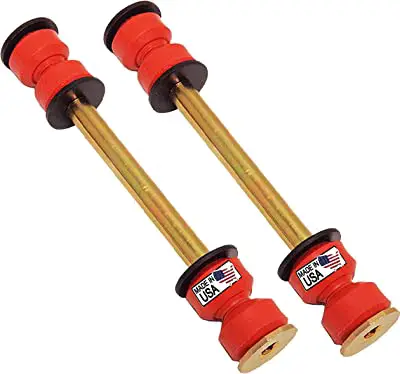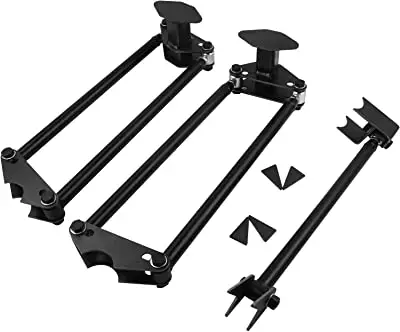When it comes to truck suspensions, there are a few things you always have to be on the lookout for. One of these things is whether the suspension utilizes a link-style design. A link-style suspension uses links to connect the frame and wheel assemblies.
Because the springs cannot locate the axle, links are required to adjust how your truck rides. Since its introduction, link suspension has evolved through different versions. At present, 4-link and 3-link suspensions are two of the most commonly used variations.
As both of them are popular and seem identical to the naked eye, people often interchange them and end up with a mess. So, how do they differ from each other? Which one should you choose for your vehicle? Read our 3-link suspension vs. 4-link suspension comparison article to find out.
What is a 3-Link Suspension?

A three-link suspension is a type of multi-link suspension with a series of three lateral arms and no transmission to support the weight. And yes, as the name suggests, they consist of three particular connecting points or links. The arms on the three-link suspension could not be identical in length. It’s angled away from its path.
Generally, the ends of the three-link suspension are sleeved with an unconstrained rubber bushing or sphere joint. Because it is spring-loaded, the tension and release of this component work in compression and tension.
A 3-link suspension is worth it because it delivers more efficiency for cornering. Unlike a 4-link suspension, it doesn’t have the binding problem and can pivot more easily. This makes it better equipped to handle curves and turns, providing a smoother ride and greater stability.
What is a 4-Link Suspension?

4-link suspension is an alteration that fits four links over both sides of the axle, with a middle locking pin on module 2 and a different security wheel on module 1.
Each of the 2 pins uses a single bar, associated with the transom of the axle, and the other locking pin is attached to an automobile, so you can place it in different locations on the apparatus as you, please. These four-link suspensions are a great progression from the 3-link suspension.
A four-link suspension is an upgrade to your car’s suspension system that provides better performance and ride quality when compared to a leaf spring suspension. By using four links to the suspension of the car, you can control the wheel independently, which results in a smoother and more stable ride. Additionally, a four-link suspension can help improve your car’s handling and cornering ability.
Read also: How To Build A 4-Link Rear Suspension
3 Link Suspension Vs 4 Link Suspension – Comparison Table
| Attribute | 3 Link Suspension | 4 Link Suspension |
| Adjustability | The structures of the 3 links meet each other at a single hole so that none of them can be adjusted. | The adjustable axle can be pivoted on, and rotated to either side, to facilitate a bare minimum setup. |
| Performance | Designed to meet the demands of motorists of on-track racing vehicles, high-performance racing cars are put into operation. | Drag racing cars with high horsepower can excel at motorsport with this suspension’s superior performance. |
| Installation | The simple fact is that the engine, exhaust, and other such components will not be altered during installations. | During installation, may need to work on the exhaust system. |
| Cornering Capacity | Offers incredible cornering capacity without any binding issue | Cornering capability might be affected due to binding issues |
3 Link Vs 4 Link Suspension – Design and Working Mechanism Comparison
Design and working mechanism are two of the most significant factors that distinguish a 3-link suspension from its 4-link counterpart. So, when deciding which type of Suspension to use for your truck, it is important to first understand the different designs and working mechanisms. Let’s analyze these two distinct facts first.
3 Link Suspension
A three-link triangulated on the lower two anchors of the frame rails and pinned to a single upper anchor is an allowed front-middle link with lump-sum otherwise known as a Panhard bar.
This is usually constructed with one frame rail attached to each of the lower anchors and one upper anchor running parallel to the frame rails. Since the Panhard bar (also known as a track bar) runs perpendicular from the frame rail to the axle, it controls sideways movement.
4 Link Suspension
The degree to which the wheel can swivel in one of four different directions is primarily dependent upon the four-link suspension. In this technique, two of the four links must be strengthened either from the automobile to the frame or from the machine to the cross member to keep the automobile from moving.
Some suspension manufacturers position the bottom two links as well as the upper two positions, however, you just need a single of these pairs. The four links combined keep the automobile axle from moving.
3 Link Suspension Vs 4 Link Suspension – Suitability
Imagine you just have grabbed a brand new set of suspension or just have built it up on your own. But, when you’re in real-life experience, you just have realized that you have made a great mistake. Yes, it sucks when you don’t pick the suitable one for your preference. So, check which driving conditions 4 links and 3 link suspensions are suitable.
3 Link Suspension
In the ideal circumstances, the three-link suspension is most responsive with a vertical bar that is straight, long, and level at ride height, but it should also be as parallel and the same in length to the linkage link as possible to reduce bump steer throughout the range of motion of the suspension.
Unlike a four-link suspension, a 3 link suspension allows for the axle to move from side to side as it rises and falls, but in most cases, the 3 link suspension is more straightforward to package than a triangulated four-link.
4 Link Suspension
To prevent bump steer, the system often requires full hydraulic steering when the axle moves in an arc since the steering box with a drag link near the frame mount of the upper suspension link has a crossover link.
We’ve observed complex steering systems with steering boxes or clevises proximate to the upper steering box, and upper and lower oval links, each of which connects to a crossbar.
With the front triangulated 4-link comparatively lightweight, the four-link setup can be set up without the need for several wheels to face away from the center of the automobile. When you’re driving on a street, we do not typically suggest the use of a four-link suspension.
3 Link Vs 4 Link Suspension – Installation
No doubt, installation is one of the most important factors you have to bear in mind. A suspension system with easy installation is always preferable. When it’s about installing a 3-link suspension, you don’t need to alter any component of your vehicle.
Whilst, for the 4-link suspension, the installation will affect the exhaust system. However, here we’re going to demonstrate installation processes for both of these suspensions.
3 Link Suspension
When you’re upgrading your truck, it’s important to keep in mind the various installation methods. Whether you’re installing a 3-link suspension or not, make sure to follow these simple steps:
- Locate your truck’s frame rails and the locations of the shocks. Mark these locations with a pencil or whiteboard.
- Place the upper and lower control arms on the frame rails where they will be electrified (marked with white lines). The shock towers should already be installed, but you may need to remove them for this step.
- Install the shock towers onto the control arms using Comet Clamp fittings and screws (if using a 3-link suspension).
- Make sure that all of the shock mounts are in place before continuing to install other parts of your suspension system.
4 Link Suspension
Adding a 4-link suspension to your truck is a great way to improve handling, performance, and overall driving experience. The installation process is simple and will take only a few minutes. Here are some tips to help you get started:
- Rename the links in your truck’s axle using a straight edge or cutting torch. This will ensure that the suspension is properly aligned and connected.
- Use an appropriately sized wrench to attach each link to the axle housing. Don’t over-tighten the connections, as this could lead to instability and poor handling.
- Make sure that all of the hardware needed for the 4-link suspension has been installed before beginning the installation process. These include nuts, bolts, hangers, and other necessary parts.
Pros and Cons of 3 Link Suspensions
Here are some of the notable pros and cons of a 3-link suspension:
Pros:
- Provides more capability to bear sideload
- Easy to install
- Ensures better suspension travel
- Efficient cornering capacity
Cons:
- An additional track bar is required
- If the tracker bar is broken, the front of the vehicle may fall off to one side.
Pros and Cons of 4 Link Suspensions
Well, you should also have a look at both the advantages and disadvantages of 4 link suspensions:
Pros:
- The departure angle is far better
- Axle wrap is always controlled
- No unusual axle movement while driving
- Superior off-road performance
Cons:
- They’re more expensive
- Installation is a bit complex
3 Link or 4 Link Suspension – Our Verdict
So, which one should you choose for your car? A 3-link suspension or a 4-link? Let’s finalize our verdict. It boils right down to whether you want hydraulic assist or just a system that steers using an axle-mounted ram.
If you select a steering gearbox (with or without assistance) with a 3-Link track bar, you will need a 4-Link. Getting a hydraulic steering system will require you to use a triangulated 4-link.
A 4-link suspension doesn’t need a rear track bar and of course, this is a huge plus point. This is because here the axle moves in the center when sitting on the ground and decompresses and rises when filling the earth.
If you have a track bar, it always causes the rear truck to move back and forth under the frame when sitting on the ground and compressing and then decompressing.
The absence of a rear track bar means that reseating or compressing the axles is simpler and smoother. If the rear axle links to a 3-link configuration, then we ought not to install this setup unless there are no restrictions with our brackets. Next, concentrate on your pickup; the first step is to determine which type of steering system.
More resources: